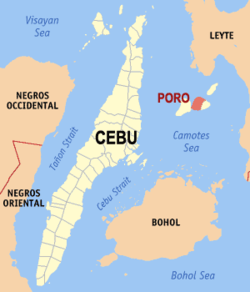Poro | |
|---|---|
| Municipality of Poro | |
 Poro town hall | |
 Map of Cebu with Poro highlighted | |
Location within the Philippines | |
| Coordinates: 10°37′44″N124°24′25″E / 10.629°N 124.407°E | |
| Country | Philippines |
| Region | Central Visayas |
| Province | Cebu |
| District | 5th district |
| Founded | 17 December 1701 |
| Barangays | 17 (see Barangays) |
| Government | |
| • Type | Sangguniang Bayan |
| • Mayor | Edgar G. Rama (One Cebu) |
| • Vice Mayor | Dina Z. Rama (One Cebu) |
| • Representative | Vincent Franco D. Frasco (One Cebu) |
| • Municipal Council | Members |
| • Electorate | 19,302 voters (2025) |
| Area | |
• Total | 63.59 km2 (24.55 sq mi) |
| Elevation | 48 m (157 ft) |
| Highest elevation | 377 m (1,237 ft) |
| Lowest elevation | 0 m (0 ft) |
| Population (2024 census) [3] | |
• Total | 26,908 |
| • Density | 420/km2 (1,100/sq mi) |
| • Households | 6,900 |
| Economy | |
| • Income class | 4th municipal income class |
| • Poverty incidence | 44.6 |
| • Revenue | ₱ 156.9 million (2022) |
| • Assets | ₱ 550.3 million (2022) |
| • Expenditure | ₱ 118.8 million (2022) |
| • Liabilities | ₱ 210.6 million (2022) |
| Service provider | |
| • Electricity | Camotes Electric Cooperative (CELCO) |
| Time zone | UTC+8 (PST) |
| ZIP code | 6049 |
| PSGC | |
| IDD : area code | +63 (0)32 |
| Native languages | Forohanon Cebuano |
Poro, officially the Municipality of Poro (Cebuano : Lungsod sa Poro; Tagalog : Bayan ng Poro), is a municipality in the province of Cebu, Philippines. According to the 2024 census, it has a population of 26,908 people. [5]
Contents
- Geography
- Barangays
- Climate
- Demographics
- Etymology and languages
- Economy
- References
- Further reading
- External links
The patronal feast of Poro is celebrated on the third Friday of January, in honour of the Santo Niño de Cebu.



